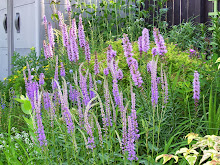 |
| Bare ground, a rarity in garden |
I have often heard the maxim, "Learn what grows good for you and grow a lot of it." When a gardener first begins this is not bad advice. At a certain point, though, you are no longer a beginning gardener, but something more. It is this something more that drives me at this point in my gardening journey.
I will confess I am a plant collector. The very nature of this statement makes garden design difficult. Finding "the repeat" with different plants or a unifying line to draw the eye can be a challenge.
Yesterday, I spent more than a couple hours digging out native Solomon seals and lily of the valley from a 2' by 6' area. The lily of the valley had even grown under the cement foundation of my porch and under a small cement slab 2' by 2' by 11/2" thick which had been placed at the foundation of my porch from rain water run-off from my sharply-inclined gable. The lily of the valley not only ran under the slab, but across the top forming a thick mat.
This was an area which when I first moved here I had no good, quick ideas as to a foundation planting scheme. I'd plunk plants in which I did not want to lose or accidentally remove. I had underplanted an Annabelle hydrangea with the lily of the valley, because the cottage feel of the "Pink Princess House" demanded it, just as it seemed to call for the row of hydrangea on the east side punctuated with the bridal wreath spirea. Even when I realized I would never grow lawn under the majestic white pine and converted the space to a hosta bed, copied by some in the village (in full sun); I never pulled the plug on my "plunking zone".
It developed itself.
 |
| I realized when looking for a "before" picture, I shoot past, or around this area. |
 |
| The removal process also includes the other side of the porch. |
 |
| A western upright juniper was moved to the corner from the center of the bed. |








Oh that sounds like fun!!
ReplyDelete